The Cheyenne
- Frederic Remington, American, 1861-1909
- Roman Bronze Works
Frederic Remington was born in Canton, New York, and attended the Yale School of Art, where he studied drawing and played football. When he was twenty years old, he traveled west for a vacation and mailed a rough sketch to Harper’s Weekly magazine, kicking off his career as an illustrator. He had tried his hand at sheep ranching in Kansas, but after a couple of years returned to New York, making trips west from his home in the East. Most of his work was created in his studio in New Rochelle, New York. Remington’s artistic career began with painting and drawing, but a friend encouraged him to try his hand at sculpture in 1895. He made 24 sculptures in his last 14 years as an artist. Remington liked the permanence of bronze sculpture: “My water colors will fade—but I am to endure in bronze,” he said. He died at age 48 at the height of his career.
Remington felt compelled to record an American West that he believed to be disappearing. He loved to portray the action and energy of the West and did not feel confined by what were considered the limits of the bronze medium. In this sculpture, Remington has defied the traditional means of supporting sculpture, making the falling robe a part of the action. The horse and rider are full of energy and appear to be moving quickly. Remington often worked from photographs to achieve this authentic image of motion. To create this bronze sculpture, Remington used a method called lost wax casting. A “cast” is a form that is created by pouring liquid metal into a mold. Although it is over 6000 years old, the lost wax method had been newly introduced in the United States during Remington’s time. The process involves six different steps—during each step a new model of the sculpture is made. Lost wax casting allows the artist to make quick changes and fine-tune the wax model before each pour. Remington took advantage of this opportunity for experimentation, and often visited the foundry that produced his casts at this stage. His additional artistic input is evident in the Denver Art Museum’s sculpture, especially in the textures and color of the piece.
Details
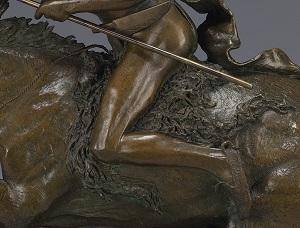
Different Textures
Compare the smooth skin of the Indian to the rippled musculature of the horse’s flank to the high relief texture of the buffalo robe. This sculpture shows the texture variation that was possible using the lost wax method, and it is evidence that this cast received a great deal of personal attention from the artist.
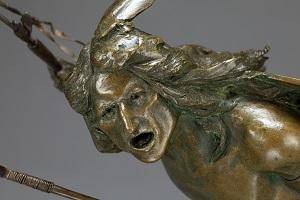
Color
The golden honey color of this particular cast is much lighter than other casts of The Cheyenne, which may be evidence that Remington himself was involved in selecting it. He usually preferred a blue-black patina, so this was probably an experiment.

Four Hooves Off the Ground
In 1878, Eadweard Muybridge’s (MY-bridge) photos of racehorses in motion proved that all four hooves leave the ground at one time. Wanting to show this in bronze, Remington added a buffalo robe falling toward the ground as a support for the flying horse.
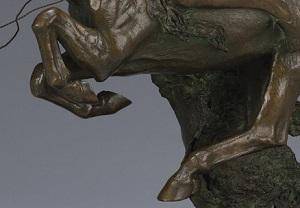
Accurate Leg Position
Muybridge’s photos also revealed another misconception: in their off-the-ground position, the horse's legs were bunched together under the belly, rather than in the “hobbyhorse attitude,” with front legs stretched forward and hind legs backward, which was traditional in painting. In using this pose for The Cheyenne, Remington was one of the first artists to take advantage of this new information.
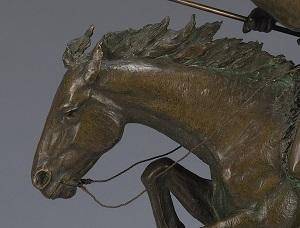
Mane & Tail
The horse’s mane and tail add to the sculpture’s sense of motion—they appear to be blown back by the wind.
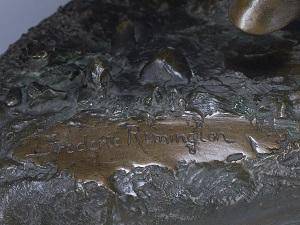
The Artist’s Signature
Remington’s signature changes location from cast to cast. On ours, it appears on the base.
More Resources
Lost Wax Casting Process
This video from the National Sculpture Society explains the lost wax casting process, the same technique Remington used in making The Cheyenne.
Websites
Legends of America
This site has a collection of legends from the American West, particularly useful for the Remington Secondary Lesson Plan found on this website.
The Metropolitan Museum of Art
The Metropolitan has a different Cheyenne cast, with links to other resources.
The American Bronze Fine Art Foundry
This website has a useful explanation of the lost wax method.
Lost Wax, Found Bronze: The Art and Technique of Lost Wax Bronze Casting
This interactive website from the National Museum of Wildlife Art goes in depth into each step of the process with images, videos and interactive tools.
The Amon Carter Museum’s website has a very detailed timeline of Remington’s life and career, including photographs.
Books
Greenbaum, Michael D. Icons of the West, Frederic Remington’s Sculpture. New York: Frederic Remington Art Museum, 1996.
Commentary about Remington’s different periods of sculpture, accompanied by many photographic examples.
Jackson, Harry. Lost Wax Bronze Casting: A photographic essay on this antique and venerable art. New York: Van Nostrand Reinhold Company, 1979.
A thorough explanation of the lost wax casting process, along with pictures to illustrate each step.
Johnson, Tim. Spirit Capture, Photographs from the National Museum of the American Indian. Smithsonian Institution Press, 1998.
A pictorial documentation of varying Native people from across America, including some history of the land and tribes.
Manley Mangum, Margaret and Atwood Manley. Frederic Remington and North Country, An Informal Biography of the Artist of the Old West. New York: E.P. Dutton, 1988.
An approachable biography about the artist.
Prodger, Phillip. Time Stands Still, Muybridge and the Instantaneous Photography Movement. New York: Oxford University Press, 2003.
This text contains a biography of Eadweard Muybridge and many examples of his work, including the horse movement study used by Remington to make his Cheyenne sculpture.
Splete, Allen and Marilyn. Frederic Remington-Selected Letters. New York: Abbeville Press, 1988.
A collection of Remington’s accounts of his experiences, through letters, over the course of his life.
St. Louis Art Museum. Frederic Remington, The Masterworks. New York: Harry N. Abrams Publishers, Inc., 1988.
Information about Remington’s life accompanied by numerous examples of his work in various mediums.
Whybrow, Helen. Dead Reckoning, Great Adventure Writing from the Golden Age of Exploration, 1800-1900. New York: W.W. Norton & Company Inc., 2003.
A collection of journal entries and personal accounts from various explorers, not just of North America, during the 19th century.
Widmark, Anne Heath. Poets of the Cowboy West, Between Earth and Sky. New York: W.W. Norton & Company Inc., 1995.
A compilation of poems by contemporary poets who live and work the cowboy lifestyle.
Children's Books
Van Steenwyk, Elizabeth. Frederic Remington. United States: Franklin Watts, 1994.
A children’s book containing a biography of Remington and some of his work.
Venezia, Mike. Frederic Remington. United States: Children’s Press, 2002.
Another children’s book about Remington’s life and art.
Funding for object education resources provided by a grant from the Morgridge Family Foundation. Additional funding provided by the William Randolph Hearst Endowment for Education Programs, and Xcel Energy Foundation. We thank our colleagues at the University of Denver Morgridge College of Education.
The images on this page are intended for classroom use only and may not be reproduced for other reasons without the permission of the Denver Art Museum. This object may not currently be on display at the museum.
